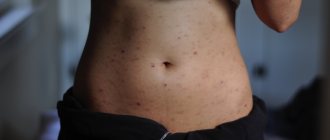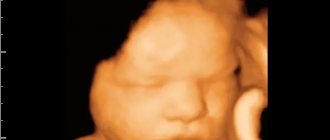Causes
This disease usually develops as a complication of an upper respiratory tract infection, such as influenza virus, ARVI, pharyngitis, acute rhinitis, measles, scarlet fever, chicken pox, herpes, whooping cough, etc. It can also begin during an exacerbation of chronic tonsillitis.
False croup of bacterial etiology (streptococci, Haemophilus influenzae, pneumococci, staphylococci) has a more severe course of the disease and is much less common. It occurs as a complication of pharyngitis.
The development of this disease is promoted by:
- weakened state of the child’s body due to birth trauma,
- artificial feeding,
- decreased immunity,
- avitaminosis,
- fetal hypoxia suffered during childbirth,
- short vocal cords,
- abundance of lymphatic formations in the mucous membrane,
- diathesis,
- rickets.
Unlike laryngitis, with false croup the inflammatory process is accompanied by stenosis of the larynx, which leads to disruption of the passage of air into the respiratory tract. Insufficient oxygen supply to the body at the initial stage of the disease can be compensated for by more intense breathing and increased work of the respiratory muscles. In turn, clearly defined stenosis already leads to oxygen starvation (hypoxia), as a result of which the functioning of the cardiovascular system and the central nervous system is disrupted.
False croup
In this article we will share information about false croup.
The book by DocDeti pediatrician Fyodor Katasonov “Pediatrics. A non-anxious approach to a child” - we recommend reading it to everyone who has children. False croup occurs in similar situations: the child falls asleep with a slight runny nose, parents, as a rule, go to bed later, but in the morning, at 4-5 o’clock, they are woken up by terrible hoarse sounds. The child is unable to take a normal breath, he gets scared and starts coughing.
Croup is a narrowing of the respiratory lumen of the larynx (larynx stenosis), which occurs for various reasons. It is false because it is similar to true croup, which occurs with diphtheria, but nowadays, due to vaccination, it is very rare.
False croup develops because the cartilage of the larynx forms a closed, inextensible ring; as a result, swelling of the tissue in this skip leads to a narrowing of the respiratory lumen.
From the age of 6 months. up to 3 years of age occurs most often, but it also occurs in children over 3 years of age.
Basically, various viruses are considered to be involved in the appearance of false croup. This is most often the case with parainfluenza. But false croup can also occur without manifestations of acute respiratory viral infections or with minimal symptoms (runny nose, low-grade fever).
Manifestations of false croup often occur in the early morning, but sometimes it can appear at any other time.
After the attack was over, there were very rarely cases of repeated croup on the same night.
During the day the child feels great, but at night during prolonged lying down, the situation may repeat.
They consider the first night to be the most difficult, after which the attacks pass easily. Basically, after 1-3 nights, false croup goes away without treatment at all.
It is necessary to distinguish between croup and:
-Acute epiglottitis (inflammation of the epiglottis) there is no hoarseness in the voice, a barking cough, but other symptoms are present, such as: difficulty swallowing, excessive salivation, severe panic, fever and lethargy.
This condition is now very rare, since vaccination against Haemophilus influenzae type b has appeared in the national vaccination calendar (Pentaxim, Act-HIB, Infanrix Hexa, Hiberix).
-Inhalation (aspiration) of foreign bodies. Absence of infection and its signs. Moreover, if it happens at 5 am, then it is unlikely that the child woke up and had time to inhale anything.
— Allergic swelling of the larynx - there are no signs of infection and the voice does not hoarse, but swelling is often observed in other places (in the eyes, lips), a rash similar to hives, there has been contact with an allergen.
- Obstructive bronchitis, asthma attacks - in this case it is difficult to exhale, not inhale (you can see that the exhalation lengthens, and at the same time the auxiliary muscles - the intercostal muscles and the diaphragm - are activated during exhalation).
What actions need to be taken?
1. If you are experiencing false croup for the first time, then most likely you do not have an inhaler. Depending on the time of year, you need to: open a window and let in fresh, cool air, or take your child to the bathroom and turn on a hot shower.
The child needs to be hugged and reassured. Try to make your breathing slower and deeper. Another family member calls an ambulance.
The effectiveness of such methods has no evidence, but they are safe and will help you calm both the child and yourself, and this is important in such a situation. It is possible that by the time the ambulance arrives, the attack will have already subsided, and you will only have to apologize, there is nothing wrong with that. This is the job of an ambulance.
If the attack does not go away, then you need to do inhalation with pulmicort (budesonide). In almost all cases, after inhalation the attack ends.
What to do if there is no inhaler in the ambulance, there is no pulmicort, or inhalation did not help (you can understand this after 15 minutes)? Then you need to ask for a hormone injection (prednisone or dexamethasone - the second will relieve swelling a little more effectively).
In rare cases, the attack does not go away, which means hospitalization is necessary.
2. If an attack has already happened, you have an inhaler and pulmicort at home. While one of the parents calls an ambulance, the other one inhales the child with pulmicort (0.5 mg/ml, 2 ml per inhalation). Most likely the attack will pass before the brigade arrives.
In cases of false croup, the use of Berodual, alkaline inhalations, mucolytics, and Erespal is not effective.
If you have pulmicort, false croup is, in principle, not so scary. But for the first time, you may be afraid of laryngeal stenosis.
First of all, do not panic; together with the arriving team, try to cope with false croup at home. Only an unsuccessful attempt to administer the hormone or symptoms uncharacteristic of false croup can cause treatment in the hospital.
Symptoms
Clinical manifestations consist of a triad of symptoms:
- hoarse voice,
- "barking" dry cough,
- heavy and noisy breathing.
Viral croup begins suddenly, and often begins to show the first signs during sleep. The disease may be preceded by malaise, hyperthermia, weakness, mild runny nose and cough.
Degree of severity of signs of stenosis:
- Compensated. It includes all those symptoms that appear only during certain physical activities, i.e. shortness of breath when inhaling (inspiratory). In this case, the blood gas composition is normal.
- Subcompensated. Increased symptoms begin to appear even at rest. In order to inhale, you have to use additional muscles, due to which the breathing process is accompanied by noise that can be heard from a distance. There may be cyanosis around the mouth and pale skin, and the patient may be restless and agitated. This condition of the child continues for 3-4 days and can take the form of pronounced attacks. It is best to start treatment at this stage to avoid adverse consequences.
- Decompensated. The main sign of the onset of this stage is a sharp deterioration in condition. This is due to sudden changes in the gas composition of the patient’s blood. All symptoms take on a permanent character and noticeably increase: shortness of breath intensifies, a more restless state is observed, periodically replaced by drowsiness, breathing is irregular (arrhythmic), cough is superficial.
- The terminal stage is asphyxia. The patient's condition is extremely serious. Breathing periodically stops, and coma may develop due to a severe lack of oxygen in the blood.
Differential diagnosis
Acute epiglottitis is a form of acute laryngitis, often of bacterial etiology, in which the epiglottis is affected. It is characterized by a sudden onset, the body position is with the head thrown back and the mouth open, there is difficulty swallowing, drooling, and fever.
Peritonsillar, parapharyngeal, retropharyngeal abscesses are purulent inflammation in the oropharynx. It is characterized by sore throat on the affected side, nasal sound, difficulty opening the mouth (trismus of mastication), drooling, stiff neck, and fever.
Allergic edema (acute angioedema). Characterized by a rapid onset without preceding symptoms of a cold or fever, swelling of the lips and tongue, rash (urticaria), and dysphagia (difficulty swallowing) are observed.
Diagnostics
To diagnose treatment, you will need the help of an otolaryngologist, therapist or pediatrician. If complications are observed in the bronchi or lungs, the patient will also be referred to a pulmonologist. In the presence of laryngeal tuberculosis, the examination is carried out jointly with a phthisiatrician, in case of syphilis with a venereologist, respectively.
To diagnose croup you will need:
- characteristic clinic,
- laryngoscopy and auscultation data,
- medical history,
- additional research.
Auscultation of the lungs allows you to listen to dry wheezing rales. Wet wheezing signals the aggravation of the painful condition. The laryngoscopy picture will allow you to assess the extent of the inflammatory process, how much the larynx is narrowed, and also reveals fibrinous films that are characteristic of diphtheria. Microscopy and analysis of throat smears (bacteria culture) make it possible to verify the causative agent of the infection. Syphilis is detected using the RPR test. A blood test allows you to judge at what stage of the disease the patient is. If complications develop, the child must undergo otoscopy, pharyngoscopy, chest x-ray, lumbar puncture or rhinoscopy, depending on the nature of the complications.
For whooping cough, retropharyngeal abscess, bronchial asthma and laryngeal tumors, a differential diagnosis of croup is carried out.
Stages of the disease
As laryngeal stenosis progresses during false croup, the following stages are distinguished:
- Compensated stenosis. Inspiratory shortness of breath that occurs during physical or emotional stress is noted, i.e., inhalation is difficult.
- Subcompensated stenosis. Inspiratory dyspnea is observed not only during exercise, but also at rest.
- Decompensated stenosis. Characterized by severe shortness of breath of inspiratory or mixed nature. In some cases, paradoxical breathing may develop, in which the volume of the chest increases during exhalation and decreases during inhalation.
- Terminal stenosis. Accompanied by the development of severe acute respiratory and cardiovascular failure, severe hypoxia. This stage of the disease often ends in death.
Treatment of false croup is aimed at stopping the attack and preventing its reoccurrence, relieving swelling and inflammation of the laryngeal mucosa.
Treatment
If a patient is diagnosed with true croup, he is immediately transferred to the infectious diseases department of a hospital clinic. Depending on the severity of the condition, immediate treatment is carried out by administering anti-diphtheria serum intravenously or intramuscularly. Detoxification treatment is also used, which consists of administering a solution of glucose, cocarboxylase and glucocorticosteroids (according to indications) using a dropper. In case of severe intoxication, extracorporeal hemocorrection methods can be used.
False croup can be cured by taking a course of antihistamines, antiseptics and sedatives. If you have a dry cough, you should take antitussives such as oxeladine, glaucine, codeine, prenoxdiazine, and if you have a wet cough, take mucolytics (ambroxol, carbocisteine, acetylcysteine).
The administration of glucocorticosteroids is necessary in the most severe cases of decompensated laryngeal stenosis. Viral croup can be treated with antiviral drugs (proteflazid, interferon alfa-2b). Bacterial false croup or the threat of re-infection require antibiotic therapy. An antibiogram during bacterial culture will help you select the most appropriate antibiotic. If there are signs of hypoxia, oxygen therapy is performed. Pronounced stenosis of the larynx, in which there is a threat of asphyxia, is an indication for tracheotomy.
In the early stages, inhalation with saline solution is sufficient for treatment. More severe stages require emergency medical and sometimes surgical intervention.
What to do after a coughing attack?
In the room where the baby spends time, you need to constantly maintain a flow of cool and humid air. If you have a humidifier, it should be running constantly. You can place a pillow under the mattress on the side of your baby's head to give him an inclined sleeping position. You need to prepare more warm drinks.
If you don't have a nebulizer at home, we highly recommend purchasing one. When treating laryngitis, inhalation is your indispensable assistant, and this device works much more effectively than simple steam breathing. Remember that ultrasound is not suitable, since the pulmicort is destroyed in it. It is best to buy a mesh inhaler - they are so compact that they even fit into your pocket, and this is very convenient if you need to go on a trip or travel.
And, of course, if your baby has an attack, you need to make an appointment with a pediatrician as soon as possible to determine the cause and quality treatment. If your child has other symptoms of illness, such as fever, or feels unwell, it is better to call a pediatrician at home. In other cases, the pediatrician can see the patient in the clinic.
Prevention
Since false croup is viral in origin, taking antibiotic drugs cannot prevent the development of the disease. The tendency to pathology of this type is due solely to the congenital predisposition of the patient and the characteristics of the virus that caused the disease. Therefore, there are no specific prevention methods yet.
General prevention:
- avoid all contact between a healthy child and infected patients,
- observe the rules of hygiene,
- maintain normal humidity in the children's room,
- drink purified water,
- Avoid the presence of strong odors in the immediate vicinity of children.
To prevent true croup and diphtheria, mass vaccination of children (from 3 months of age) is carried out.










